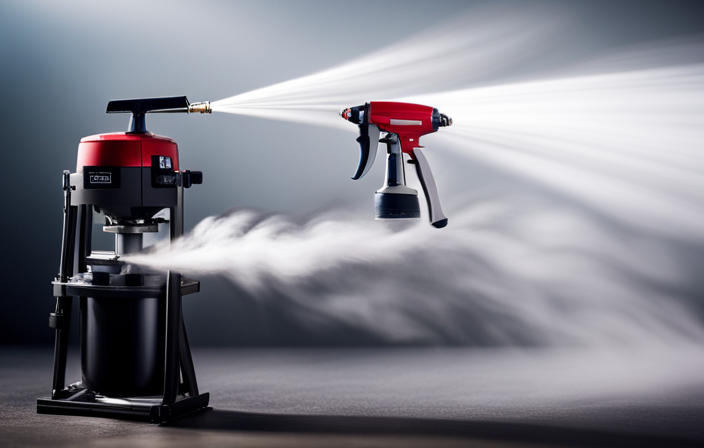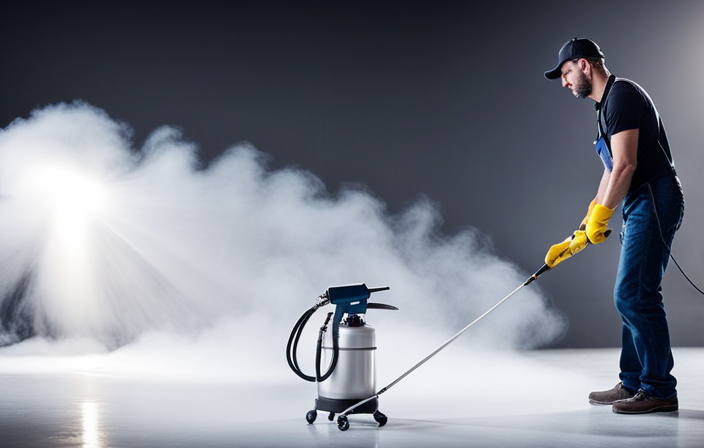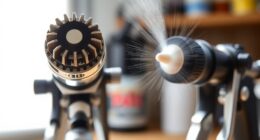Have you ever attempted to paint a sizable area using a brush or roller, only to be left with streaks and an uneven finish? I certainly have, and it can be quite exasperating. That’s why I was thrilled to come across airless paint sprayers.
These powerful machines use high pressure to atomize paint into tiny droplets, creating a smooth and even coat on any surface.
In this article, I will take you through the inner workings of an airless paint sprayer and explain how it achieves such impressive results. We’ll explore the basic components, the pressure creation process, and the advantages of using an airless sprayer.
Additionally, I’ll provide tips on spray pattern and pressure control, proper preparation, safety considerations, maintenance, and troubleshooting.
Whether you’re a professional painter or a DIY enthusiast, understanding how airless paint sprayers work will revolutionize your painting experience. So, let’s dive in and unlock the secrets behind this remarkable tool.
Key Takeaways
- Airless paint sprayers provide a smooth and even finish.
- They save time compared to traditional painting methods.
- They allow for faster coverage of large areas.
- They reduce paint waste and overspray.
The Basic Components of an Airless Paint Sprayer
An airless paint sprayer consists of several basic components that work together to create pressure and propel paint onto surfaces. These components include:
-
Motor: The motor is responsible for powering the sprayer and creating the necessary pressure to atomize the paint.
-
Pump: The pump is the heart of the airless paint sprayer. It draws paint from the container and pressurizes it, allowing it to be sprayed.
-
Hose: The hose connects the pump to the spray gun and allows the pressurized paint to flow from the pump to the gun.
-
Spray Gun: The spray gun is where the magic happens. It is equipped with a trigger that controls the flow of paint. When the trigger is pulled, the pressurized paint is released in a fine mist.
-
Nozzle: The nozzle is the final component in the process. It is responsible for atomizing the paint and delivering it in a fine mist. Different nozzle types are available for different applications, such as spraying latex paint or stains.
By understanding the basic components of an airless paint sprayer, you can make informed decisions about nozzle selection and paint viscosity, ensuring an even spray pattern and a smooth painting experience.
How Airless Paint Sprayers Create Pressure
The incredible pressure generated by the high-powered mechanism inside an airless paint sprayer is created through a combination of hydraulic force and a piston pump. The paint is drawn into the pump through a suction tube and then forced into a small chamber. As the piston moves forward, it compresses the paint, increasing the pressure.
This high-pressure paint is then forced through a hose and out of a small tip at the end of the sprayer. This method of pressure generation allows airless paint sprayers to deliver a consistent and powerful stream of paint, resulting in an even and smooth finish.
The benefits of using airless sprayers include faster application times, better coverage, and reduced overspray. With this understanding of pressure generation, let’s now explore the advantages of airless paint sprayers.
Advantages of Airless Paint Sprayers
When it comes to airless paint sprayers, there are several advantages that make them a superior choice.
Firstly, they allow for faster application as they can cover a larger surface area in less time compared to traditional paint brushes or rollers.
Secondly, airless paint sprayers provide a smooth and even coverage, resulting in a professional finish without any brush or roller marks.
Lastly, the versatility of airless paint sprayers is unmatched, as they can handle a wide range of paint types, including latex, oil-based, and even thicker materials like elastomerics.
Faster Application
By utilizing high-pressure technology, airless paint sprayers significantly speed up the application process, allowing for a more efficient and time-saving painting experience. With airless paint sprayers, you can achieve a faster application of paint compared to traditional methods. Here are three key reasons why airless paint sprayers excel in time efficiency:
-
Increased coverage: The high-pressure mechanism of airless paint sprayers enables the paint to be distributed evenly, covering a larger surface area in a shorter period of time.
-
Reduced overspray: Unlike conventional paint sprayers, airless paint sprayers atomize the paint into fine particles, minimizing overspray and eliminating the need for time-consuming touch-ups.
-
Quick setup and cleanup: Airless paint sprayers are easy to set up and clean, saving you valuable time during preparation and post-painting tasks.
With faster application and improved time efficiency, airless paint sprayers pave the way for the subsequent section on achieving smooth and even coverage.
Smooth and Even Coverage
The airless paint sprayer achieves smooth and even coverage through advanced spraying techniques. It atomizes the paint into tiny particles and propels them at high pressure through a small opening in the spray gun tip. This creates a fine mist of paint that evenly coats the surface. The high pressure also helps to force the paint into crevices and uneven surfaces, ensuring complete coverage.
The airless paint sprayer offers adjustable pressure settings, allowing the user to customize the flow of paint for different surfaces and paint types. This versatility in paint types will be further explored in the subsequent section about its ability to handle various materials.
Versatility in Paint Types
As we discussed earlier, airless paint sprayers are known for providing smooth and even coverage. However, another advantage of these sprayers is their versatility in handling different paint types and finishes. Whether it’s latex, oil-based, or even specialty paints like epoxy, airless paint sprayers can handle them all. This is due to their powerful pumping system that atomizes the paint into a fine mist, ensuring a consistent application. To further illustrate this point, consider the following table:
| Paint Type | Finish | Spraying Technique |
|---|---|---|
| Latex | Matte | Crosshatch |
| Oil-based | Glossy | Circular |
| Epoxy | Satin | Up and down |
By adjusting the spraying technique, you can achieve the desired finish for each paint type. Understanding the spray pattern and pressure control is crucial for achieving optimal results, as we will explore in the subsequent section.
Understanding the Spray Pattern and Pressure Control
Mastering the spray pattern and pressure control of an airless paint sprayer will give you complete control over the final result.
When it comes to spray pattern control, it is essential to understand that the shape, width, and consistency of the spray pattern can be adjusted by altering the nozzle tip size, fan width adjustment, and the distance between the sprayer and the surface. By experimenting with different nozzle tips and fan widths, you can achieve a desired spray pattern, whether it is horizontal, vertical, or circular.
Additionally, pressure adjustment techniques play a crucial role in achieving the desired finish. By adjusting the pressure, you can control the flow rate and atomization of the paint particles, resulting in a smooth and even application.
Understanding the spray pattern and pressure control is vital for achieving professional-looking results.
Transitioning into the subsequent section, proper preparation for using an airless paint sprayer is equally important to ensure a successful painting project.
Proper Preparation for Using an Airless Paint Sprayer
Before using an airless paint sprayer, it’s essential to properly prepare the surface to be painted. This involves thoroughly cleaning and repairing any imperfections. Any dirt or flaws on the surface can affect the final finish, so taking the time to address them is crucial.
In addition to preparing the surface, it’s also important to mask and protect surrounding areas. This helps prevent overspray and ensures a neat and professional-looking paint job. By taking the time to properly mask off areas that should not be painted, I can avoid any unnecessary mess or damage.
By paying attention to these key points, I can ensure that my airless paint sprayer works efficiently and produces a flawless result. Taking the time to properly prepare the surface and protect surrounding areas is well worth the effort for a successful painting project.
Surface Cleaning and Repair
To prepare your surface for painting, follow these steps:
- Smooth out any rough spots or imperfections using a sanding block.
- Visually inspect the surface for cracks, holes, or peeling paint.
- Use a putty knife or scraper to remove any loose or flaking paint.
- Clean the surface with a mild detergent and water solution to remove dirt, grease, and grime.
- For stubborn stains, consider using a stronger cleaning agent or solvent.
- Allow the surface to dry completely before moving on to the next step.
- This ensures proper adhesion and longevity of the paint.
- Now, let’s move on to the next step of masking and protecting surrounding areas.
Masking and Protecting Surrounding Areas
After thoroughly cleaning and repairing the surface, the next step in preparing for airless paint spraying is masking and protecting the surrounding areas. This crucial step ensures that paint only goes where it is intended and prevents any accidental splatters or overspray. To accomplish this, there are several masking techniques that can be employed.
-
Tape and paper: Using high-quality painter’s tape, carefully mask off any trim, windows, or other areas that should not be painted. Then, cover the rest of the surrounding surfaces with protective paper or plastic to safeguard against accidental paint drips or overspray.
-
Drop cloths: Lay down drop cloths to protect the flooring or any large surfaces that cannot be easily covered with tape and paper.
-
Plastic sheeting: For larger areas or entire rooms, plastic sheeting can be used to create a barrier and protect against paint overspray.
By employing these surface protection and masking techniques, you can ensure a clean and professional paint job. Now, let’s move on to discussing the techniques for using an airless paint sprayer.
Techniques for Using an Airless Paint Sprayer
While using an airless paint sprayer, mastering techniques such as maintaining a consistent spraying distance and controlling stroke speed greatly enhances painting quality and efficiency. Keeping the sprayer at a constant distance from the surface ensures an even distribution of paint, avoiding patches or drips. Controlling stroke speed prevents overspray and allows for better coverage. Properly maintaining the sprayer involves thorough cleaning after each use and promptly addressing clogs or blockages. Troubleshooting techniques like adjusting pressure settings or checking filters can resolve any painting process issues. Now, let’s discuss safety considerations when using an airless paint sprayer…
Safety Considerations When Using an Airless Paint Sprayer
When using an airless paint sprayer, it is important to prioritize safety. Here are some key considerations to keep in mind:
-
Personal protective equipment (PPE): Always wear a respirator mask, safety goggles, gloves, and protective clothing to avoid inhaling paint fumes or getting paint on your skin.
-
Proper ventilation measures: Make sure you are working in a well-ventilated area or use exhaust fans to remove paint fumes from the environment.
-
Maintain a safe distance: Keep a safe distance from the spray tip to avoid accidental contact with the high-pressure stream of paint.
-
Secure your work area: Clear the surrounding area of any obstacles or tripping hazards to prevent accidents.
Following these safety measures ensures a safe working environment when using an airless paint sprayer.
Moving on to the next section, let’s discuss the maintenance and cleaning of an airless paint sprayer.
Maintenance and Cleaning of an Airless Paint Sprayer
To keep your airless paint sprayer in top condition, it’s important to regularly maintain and clean it. Proper maintenance will ensure optimal performance and extend the lifespan of your sprayer. Here are some maintenance tips to follow:
-
Flush the system after each use: After painting, flush the sprayer with water or a recommended cleaning solution. This will remove any leftover paint and prevent clogs.
-
Lubricate moving parts: Apply a few drops of lubricant to the piston and packings to keep them functioning smoothly.
-
Check filters and tips: Clean or replace filters regularly to prevent debris from clogging the system. Inspect the spray tip for wear and replace if necessary.
-
Store properly: When not in use, store the sprayer in a clean, dry place to prevent rust and damage.
Recommended cleaning solutions for airless paint sprayers include mild detergent solutions or specialized cleaning agents specifically designed for removing paint residue.
By following these maintenance tips and using the recommended cleaning solutions, you can ensure that your airless paint sprayer remains in optimal condition.
In the next section, we will discuss troubleshooting common issues with airless paint sprayers.
Troubleshooting Common Issues with Airless Paint Sprayers
If your trusty paint-spewing contraption decides to throw a temper tantrum, fear not, for we shall now delve into the realm of troubleshooting common issues.
When faced with problems, it is important to employ effective troubleshooting techniques to quickly identify and resolve the issue at hand. Here are four common issues you may encounter with your airless paint sprayer and how to troubleshoot them:
-
Clogged Nozzle: If the paint is not spraying evenly or not at all, the nozzle may be clogged. Clean the nozzle thoroughly using a nozzle cleaning kit or a small wire brush to remove any debris or dried paint.
-
Low Pressure: If the sprayer is not producing enough pressure, check the inlet filter for clogs and clean or replace it if necessary. Additionally, ensure that the paint supply is sufficient and not running low.
-
Excessive Overspray: If the paint is spraying beyond the desired area, adjust the spray tip to a narrower pattern and decrease the pressure to reduce overspray. Additionally, maintain a consistent distance from the surface being painted.
-
Inconsistent Spray Pattern: If the spray pattern is uneven or splotchy, check the spray tip for wear or damage. Replace the spray tip if necessary. Also, make sure that the paint is properly mixed and strained to avoid any clumps or inconsistencies.
By employing these troubleshooting techniques, you can overcome common issues and ensure optimal performance from your airless paint sprayer.
Now, let’s transition to the subsequent section about choosing the right airless paint sprayer for your needs.
Choosing the Right Airless Paint Sprayer for Your Needs
When it comes to choosing the right airless paint sprayer, it’s important to consider factors such as the size of your project, the type of paint you’ll be using, and your level of experience.
For small projects or occasional use, a portable airless sprayer with a lower pressure rating may be sufficient. However, for larger projects or professional use, a high-pressure airless sprayer with a larger motor and higher flow rate would be more suitable.
Additionally, it’s crucial to consider the maintenance and troubleshooting capabilities of the paint sprayer. Look for models that are easy to clean and maintain, with readily available replacement parts.
Some sprayers may also have built-in features for troubleshooting common issues, such as clogs or pressure fluctuations. By selecting a paint sprayer that meets these criteria, you can ensure efficient and hassle-free operation, saving both time and money in the long run.
Frequently Asked Questions
Can I use an airless paint sprayer for all types of paint?
Yes, an airless paint sprayer can be used for all types of paint. However, it is important to understand the maintenance required and follow tips for efficient usage, such as checking for clogs and adjusting pressure settings.
How do I adjust the spray pattern on an airless paint sprayer?
To adjust the spray pattern on an airless paint sprayer, first locate the pattern adjustment knob. Turn it clockwise to make the pattern narrower, or counterclockwise to make it wider. If troubleshooting spray pattern issues, ensure the nozzle is clean and properly aligned.
Can I use an airless paint sprayer indoors?
Can I use an airless paint sprayer indoors? Airless paint sprayers are safe for indoor use when proper safety precautions are followed. They provide efficient and even coverage, reducing overspray and saving time and effort.
How do I clean the spray gun on an airless paint sprayer?
To clean the spray gun on an airless paint sprayer, first, disconnect the gun from the paint source. Then, remove the nozzle and filter, and clean them with warm soapy water. Finally, reassemble the gun and perform a test spray. Regular cleaning is essential for optimal performance and longevity of the sprayer.
Are airless paint sprayers difficult to use for beginners?
Airless paint sprayers can be challenging for beginners due to their high-pressure operation and potential for overspray. However, the advantages of faster and more even coverage make them worth the learning curve.
Conclusion
In conclusion, airless paint sprayers are a highly efficient and effective tool for achieving professional-quality paint finishes. They work by using powerful pumps to create high pressure, which allows for a consistent and even coat of paint on various surfaces.
One example of their effectiveness is a hypothetical case study where a homeowner successfully paints their entire exterior in half the time it would have taken using traditional brushes and rollers. This showcases the time-saving and superior results that can be achieved with an airless paint sprayer.










